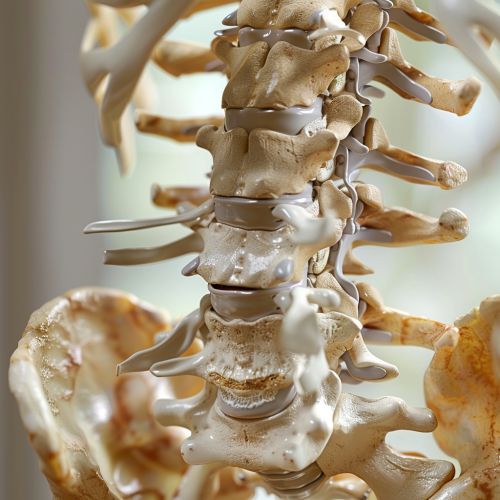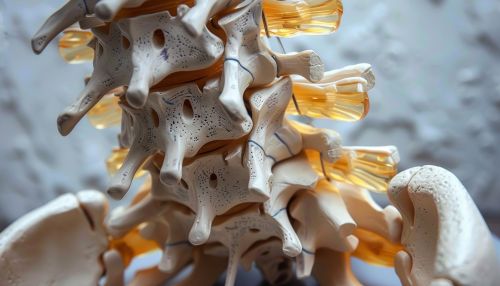Spine
Anatomy of the Spine
The human spine, also known as the vertebral column or backbone, is a complex structure consisting of 33 individual bones stacked one on top of another. It forms the main part of the axial skeleton, providing support and protection for the spinal cord, which is the main pathway for communication between the brain and the rest of the body.


Vertebrae
The spine is divided into five regions, each containing a different number of vertebrae. From top to bottom, these regions are the cervical (neck), thoracic (chest), lumbar (lower back), sacral, and coccygeal (tailbone) regions.
The cervical vertebrae (C1-C7) are the smallest and most mobile, allowing for a wide range of head movement. The thoracic vertebrae (T1-T12) are larger and less mobile, with each one articulating with a pair of ribs. The lumbar vertebrae (L1-L5) are the largest and bear the most weight. The sacral region consists of five fused vertebrae (S1-S5), forming the sacrum, which articulates with the pelvis at the sacroiliac joints. The coccygeal region typically consists of four small, fused vertebrae forming the coccyx, or tailbone.
Intervertebral Discs
Between each pair of vertebrae is an intervertebral disc, a fibrocartilaginous pad that acts as a shock absorber and allows for movement between the vertebrae. Each disc consists of a tough outer layer, the annulus fibrosus, and a gel-like inner core, the nucleus pulposus.
Spinal Cord and Nerves
The spinal cord runs through the central canal of the vertebral column, protected by the bony vertebrae. It is part of the central nervous system, along with the brain, and is responsible for transmitting signals between the brain and the rest of the body. Exiting from the spinal cord between each pair of vertebrae are pairs of spinal nerves, which carry sensory and motor information to and from specific regions of the body.
Function of the Spine
The spine serves several crucial functions in the body. It provides structural support, allowing us to stand upright, bend, and twist. It also protects the spinal cord and the nerve roots, and serves as an attachment site for muscles and ligaments.
Posture and Movement
The spine plays a crucial role in maintaining posture and facilitating movement. The unique shape of the spine, with its curves and flexibility, allows for a wide range of movements, including bending forward and backward, twisting, and side bending.
Protection of the Spinal Cord
One of the most important functions of the spine is to protect the spinal cord and nerve roots. The vertebral bodies and the surrounding structures form a protective canal for the spinal cord, while the intervertebral foramina provide exit points for the spinal nerves.
Spinal Conditions and Disorders
There are many conditions and disorders that can affect the spine, ranging from congenital abnormalities to degenerative diseases, injuries, and infections. Some of the most common spinal conditions include herniated discs, spinal stenosis, scoliosis, and osteoporosis.
Herniated Discs
A herniated disc, also known as a slipped or ruptured disc, occurs when the nucleus pulposus pushes out through a tear in the annulus fibrosus. This can put pressure on the spinal nerves, causing pain, numbness, or weakness in the area of the body served by those nerves.
Spinal Stenosis
Spinal stenosis is a narrowing of the spaces within the spine, which can put pressure on the spinal cord and the spinal nerves. It is most often caused by wear-and-tear changes in the spine related to osteoarthritis.
Scoliosis
Scoliosis is a condition in which the spine curves to the side, often in an S or C shape. It most commonly occurs during the growth spurt just before puberty.
Osteoporosis
Osteoporosis is a condition that weakens bones, making them fragile and more likely to break. It can affect any bone, but the spine is one of the most common sites.
